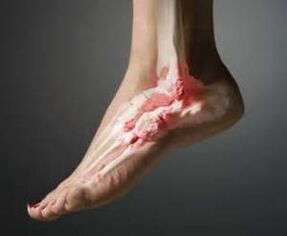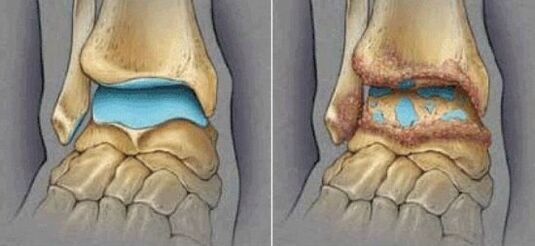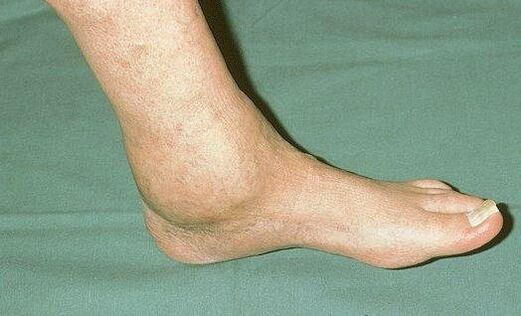
Ankle osteoarthritis is a dystrophic degenerative pathological disorder characterized by the gradual destruction of cartilage, joints and adjacent bone structures, and ligaments and even muscles, leading to reduced mobility and even disability of the patient. The reason for the development of such pathology may be a traumatic injury, in which develops post-traumatic osteoarthritis of the ankle, metabolic disorders in the body or some inflammatory diseases.
Do not self-medicate. At the first signs of illness, see a doctor.
The diagnosis of pathology is made taking into account the patient's complaints, as well as on the basis of the results of X-ray examination and ultrasound. The disease needs to be treated mostly conservatively and only in severe (neglected) cases is surgical intervention indicated.
The disease has a chronic wavy course, in which periods of exacerbation alternate with periods of lull, but still the progression of pathology, even in the absence of symptoms, continues, so over time the ankle joint is completely destroyed if treated. not implemented. Arthrosis most often affects the elderly, due to the natural metabolic processes in the body, but there are other reasons for arthrosis.
Causes
There are two types of osteoarthritis in medical practice: primary and secondary. Primary developed as an independent pathology, for no reason. It is a secondary result of any adverse effects, for example, traumatic injuries.
The main causes of the disease can be the following:
- diabetes;
- thyroid disease;
- excess weight;
- persistent microtrauma that can occur in people who play sports or regularly walk on high heels;
- rheumatic pathologies;
- traumatic injuries in this area (fracture, dislocation);
- inflammatory processes that develop as a result of diseases such as gout, arthritis;
- hereditary metabolic disorders that lead to tissue thinning.

Sometimes the disease occurs in children, and its causes can be:
- tissue dysplasia;
- congenital anomalies;
- thyrotoxicosis;
- trauma;
- joint inflammatory diseases.
Degrees and symptoms
Ankle osteoarthritis has three stages, which determine the symptoms of the disease. It is important to remember that the disease develops gradually, so the disorders in the joint will be insignificant at first, and then more and more pronounced. At the same time, the changes that have occurred are already irreversible, and the treatment of pathology at one stage or another will consist only of preventing the progression of the disease.
In the first degree of the disease, the tissue becomes thinner, and this does not happen on the entire surface, but in separate parts - specific islets are formed.
The disease of the first degree is characterized by the following symptoms:
- excessive fatigue with prolonged stress on the legs;
- discomfort in the joint area after walking in heels;
- less pain that disappears at rest.
X-ray or ultrasound examination does not reveal any pathological changes in the joint, so at this stage doctors cannot make a diagnosis.
In the first phase of the disease, it can be treated at home with folk remedies - first of all, refuse to wear heels, lose weight (if necessary), conduct exercise therapy, and also use some folk methods, which will be discussed below.
In the second stage of the pathological process in those areas where the tissue has thinned, the load falls on the lower bone. It therefore grows, forming osteophytes, which injure healthy areas of cartilage tissue located opposite or nearby. The symptoms of the second degree of arthrosis are already more obvious, and they are:
- pain with less stress, which does not go away immediately after it stops;
- the appearance of night pains that interfere with the quality of sleep;
- limitation of joint mobility in the morning (it takes some time to act);
- joint response to weather conditions.
In the third degree, deforming arthrosis of the ankle joint develops. During this period, the tissues of the entire joint become thinner, as well as the bone structures, the muscles on the one hand are overloaded, and on the other hand they spasm, trying to keep the joint in the correct position. Symptoms of the third degree of such pathology as deforming arthrosis of the ankle joint are associated with complete violation of its mobility and severe pain:
- severe pain that does not stop even at rest;
- in the morning, the joint needs long-term development even to make minimal movements;
- feeling of crunch;
- the need to take painkillers to relieve pain;
- restriction or even complete impairment of mobility in the affected area.
Pathology such as traumatic osteoarthritis of the ankle is characterized by some other symptoms:
- swelling and redness in the affected area;
- local temperature rise;
- crunch or crepitus.

Diagnosis and treatment
The decisive role in the diagnosis of the disease is attributed to the X-ray examination. However, it is important for the doctor to listen to the patient's complaints, which can enable him to make a diagnosis at an early stage, when radiographic changes are not visible. In severe cases, the patient is referred for an ankle CT or MRI.
Treatment of ankle osteoarthritis depends on the stage of the disease. In the initial phase, it is enough to change the lifestyle and the correct motor regime. Massage and exercise therapy will be helpful at this stage, which will improve blood circulation. If we talk about the treatment of folk remedies that can be used at home, then it can reduce pain and alleviate the inflammatory process. These folk remedies that anyone can use at home are:
- rubbing olive oil into the affected area in the morning;
- the use of burdock leaves in the form of supplements on a sore wrist throughout the night;
- prepare comfrey ointment and rub it into the affected area twice a day;
- taking mumiyo inside in tablet form and rubbing into the affected joint.
There are other alternative methods of treatment, but it is important to remember that they are not a cure for the disease and that only their complex application with drug therapy, diet, exercise therapy and proper lifestyle will stop the progression of destruction.
If we are talking about the treatment of osteoarthritis of the ankle with drugs, then it consists in the use of anti-inflammatory and analgesic drugs. In addition, patients are prescribed chondroprotectors that protect the joint for a long time (at least six months).
The use of vascular drugs such as niacin is indicated to improve the nutrition of the affected joint. Hyaluronic acid therapy is considered effective, and in some cases a single application of hormones is required.
It is also necessary to treat the disease in combination with physiotherapy methods. Special exercises for osteoarthritis of the ankle are shown, which are chosen by the physiotherapist in each case. It is very important that gymnastics with osteoarthritis of the ankle does not cause pain to the patient, but at the same time the person should feel some discomfort, because otherwise the procedure will be ineffective.
Among other physiotherapeutic methods, the following are presented:
- magnetotherapy;
- laser therapy;
- phonophoresis;
- thermal procedures and some other types of exposure.
Surgery for this disease is indicated only in severe cases when the joint is completely destroyed. Often patients have joint prostheses, which restore the mobility of their limbs, but other surgical techniques are also used - the choice is made by the doctor taking into account the patient's condition.

























